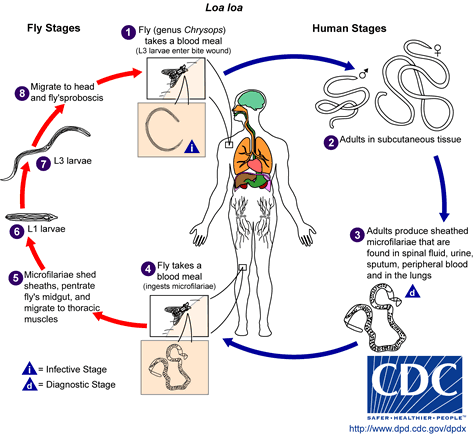Loa loa filariasis pathophysiology: Difference between revisions
(Created page with "__NOTOC__ {{Loa loa filariasis}} {{CMG}} {{AE}} {{KD}} ==Overview== ==Pathophysiology== 500 px|center The vector for Loa loa filariasis are flies...") |
|||
| Line 5: | Line 5: | ||
==Pathophysiology== | ==Pathophysiology== | ||
[[Image:L loa LifeCycle.gif|500 px|center]] | [[Image:L loa LifeCycle.gif|500 px|center]] | ||
The vector for Loa loa filariasis are flies from two species of the genus Chrysops, C. silacea and C. dimidiata. During a blood meal, an infected fly (genus Chrysops, day-biting flies) introduces third-stage filarial larvae onto the skin of the human host, where they penetrate into the bite wound '''(1)'''. The larvae develop into adults that commonly reside in subcutaneous tissue '''(2)'''. The female worms measure 40 to 70 mm in length and 0.5 mm in diameter, while the males measure 30 to 34 mm in length and 0.35 to 0.43 mm in diameter. Adults produce microfilariae measuring 250 to 300 μm by 6 to 8 μm, which are sheathed and have diurnal periodicity. Microfilariae have been recovered from spinal fluids, urine, and sputum. During the day they are found in peripheral blood, but during the noncirculation phase, they are found in the lungs '''(3)'''. The fly ingests microfilariae during a blood meal '''(4)''' . After ingestion, the microfilariae lose their sheaths and migrate from the fly's midgut through the hemocoel to the thoracic muscles of the arthropod '''(5)'''. There the microfilariae develop into first-stage larvae '''(6)''' and subsequently into third-stage infective larvae '''(7)'''. The third-stage infective larvae migrate to the fly's proboscis '''(8)'''and can infect another human when the fly takes a blood meal '''(1)'''. | The vector for Loa loa filariasis are flies from two species of the genus Chrysops, C. silacea and C. dimidiata. During a blood meal, an infected fly (genus Chrysops, day-biting flies) introduces third-stage filarial larvae onto the skin of the human host, where they penetrate into the bite wound '''(1)'''. The larvae develop into adults that commonly reside in subcutaneous tissue '''(2)'''. The female worms measure 40 to 70 mm in length and 0.5 mm in diameter, while the males measure 30 to 34 mm in length and 0.35 to 0.43 mm in diameter. Adults produce microfilariae measuring 250 to 300 μm by 6 to 8 μm, which are sheathed and have diurnal periodicity. Microfilariae have been recovered from spinal fluids, urine, and sputum. During the day they are found in peripheral blood, but during the noncirculation phase, they are found in the lungs '''(3)'''. The fly ingests microfilariae during a blood meal '''(4)''' . After ingestion, the microfilariae lose their sheaths and migrate from the fly's midgut through the hemocoel to the thoracic muscles of the arthropod '''(5)'''. There the microfilariae develop into first-stage larvae '''(6)''' and subsequently into third-stage infective larvae '''(7)'''. The third-stage infective larvae migrate to the fly's proboscis '''(8)''' and can infect another human when the fly takes a blood meal '''(1)'''. | ||
== References == | == References == | ||
Revision as of 21:03, 21 December 2012
|
Loa Loa Filariasis Microchapters |
|
Diagnosis |
|---|
|
Treatment |
|
Case Studies |
|
Loa loa filariasis pathophysiology On the Web |
|
American Roentgen Ray Society Images of Loa loa filariasis pathophysiology |
|
Risk calculators and risk factors for Loa loa filariasis pathophysiology |
Editor-In-Chief: C. Michael Gibson, M.S., M.D. [1] Associate Editor(s)-in-Chief: Kalsang Dolma, M.B.B.S.[2]
Overview
Pathophysiology

The vector for Loa loa filariasis are flies from two species of the genus Chrysops, C. silacea and C. dimidiata. During a blood meal, an infected fly (genus Chrysops, day-biting flies) introduces third-stage filarial larvae onto the skin of the human host, where they penetrate into the bite wound (1). The larvae develop into adults that commonly reside in subcutaneous tissue (2). The female worms measure 40 to 70 mm in length and 0.5 mm in diameter, while the males measure 30 to 34 mm in length and 0.35 to 0.43 mm in diameter. Adults produce microfilariae measuring 250 to 300 μm by 6 to 8 μm, which are sheathed and have diurnal periodicity. Microfilariae have been recovered from spinal fluids, urine, and sputum. During the day they are found in peripheral blood, but during the noncirculation phase, they are found in the lungs (3). The fly ingests microfilariae during a blood meal (4) . After ingestion, the microfilariae lose their sheaths and migrate from the fly's midgut through the hemocoel to the thoracic muscles of the arthropod (5). There the microfilariae develop into first-stage larvae (6) and subsequently into third-stage infective larvae (7). The third-stage infective larvae migrate to the fly's proboscis (8) and can infect another human when the fly takes a blood meal (1).